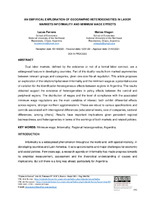| dc.rights.license | Licencia de Creative Commons Reconocimiento-NoComercial-CompartirIgual 4.0 Internacional (CC BY-NC-SA 4.0) | |
| dc.creator | Ferrero, Lucas | |
| dc.creator | Hisgen, Carlos Matías | |
| dc.date.accessioned | 2021-03-15T19:10:02Z | |
| dc.date.available | 2021-03-15T19:10:02Z | |
| dc.date.issued | 2021-01-29 | |
| dc.identifier.citation | Ferrero, L., y Hisgen, C. M. (2021). An empirical exploration of geographic heterogeneities in labor markets informality and minimum wage effects. Visión de Futuro, Revista Científica. Posadas (Misiones): UNaM. FCE. PPA; 25(1), 194-226. | es_AR |
| dc.identifier.issn | 1668-8708 | |
| dc.identifier.other | VF-066 | |
| dc.identifier.uri | https://hdl.handle.net/20.500.12219/2828 | |
| dc.identifier.uri | https://doi.org/10.36995/j.visiondefuturo.2021.25.01.005.en | |
| dc.identifier.uri | https://visiondefuturo.fce.unam.edu.ar/index.php/visiondefuturo/article/view/490/345 | |
| dc.description | Fil: Ferrero,Lucas. National University of the Northeast. School of Economics; Argentina. | es_AR |
| dc.description | Fil: Hisgen, Matías. National University of the Northeast. School of Economics; Argentina. | es_AR |
| dc.description.abstract | Dual labor markets, defined by the existence or not of a formal labor contract, are a widespread feature in developing countries. Part of this duality results from marked asymmetries between relevant groups and categories, given one-size-fits-all regulation. This article proposes an exploration of the relationship between informality and the minimum wage as a potential source of variation for the identification heterogeneous effects between regions in Argentina. The results obtained support the existence of heterogeneities in policy effects between the central and peripheral regions. The distribution of wages and the level of compliance with the associated minimum wage regulations are the main variables of interest; both exhibit differential effects across regions, stronger northern agglomerations. These are robust to various specifications and controls associated with interregional differences (educational levels, size of companies, sectoral differences, among others). Results have important implications given persistent regional backwardness, and heterogeneities in terms of the workings of both markets and related policies. | en |
| dc.format | application/pdf | |
| dc.language.iso | eng | en |
| dc.publisher | Universidad Nacional de Misiones. Facultad de Ciencias Económicas. Programa de Posgrado en Administración | es_AR |
| dc.rights.uri | http://creativecommons.org/licenses/by-nc-sa/4.0/ | |
| dc.source | Visión de Futuro (Misiones), 1-2021; 25(1): pp. 194-226. https://visiondefuturo.fce.unam.edu.ar/index.php/visiondefuturo/index | |
| dc.subject | Minimum wage | en |
| dc.subject | Informality | en |
| dc.subject | Regional heterogeneities | en |
| dc.subject | Argentina | es |
| dc.title | An empirical exploration of geographic heterogeneities in labor markets informality and minimum wage effects | en |
| dc.type | info:eu-repo/semantics/article | |
| dc.type | info:ar-repo/semantics/artículo | |
| dc.type | info:eu-repo/semantics/publishedVersion | |




